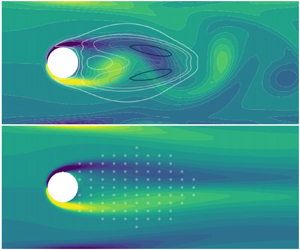Crossref Citations
This article has been cited by the following publications. This list is generated based on data provided by
Crossref.
Zheng, Changdong
Xie, Fangfang
Ji, Tingwei
Zhang, Xinshuai
Lu, Yufeng
Zhou, Hongjie
and
Zheng, Yao
2022.
Data-efficient deep reinforcement learning with expert demonstration for active flow control.
Physics of Fluids,
Vol. 34,
Issue. 11,
Viquerat, J.
Meliga, P.
Larcher, A.
and
Hachem, E.
2022.
A review on deep reinforcement learning for fluid mechanics: An update.
Physics of Fluids,
Vol. 34,
Issue. 11,
Kurz, Marius
Offenhäuser, Philipp
Viola, Dominic
Resch, Michael
and
Beck, Andrea
2022.
Relexi — A scalable open source reinforcement learning framework for high-performance computing.
Software Impacts,
Vol. 14,
Issue. ,
p.
100422.
Zhou, Lei
Zhang, Zhenzhen
Zhang, Bingchao
and
Tse, K. T.
2022.
Receptivity-orientated drag reduction of twin cylinders by steady leading-edge suction control based on adjoint method.
Physics of Fluids,
Vol. 34,
Issue. 12,
Varela, Pau
Suárez, Pol
Alcántara-Ávila, Francisco
Miró, Arnau
Rabault, Jean
Font, Bernat
García-Cuevas, Luis Miguel
Lehmkuhl, Oriol
and
Vinuesa, Ricardo
2022.
Deep Reinforcement Learning for Flow Control Exploits Different Physics for Increasing Reynolds Number Regimes.
Actuators,
Vol. 11,
Issue. 12,
p.
359.
Wang, Bofu
Wang, Qiang
Zhou, Quan
and
Liu, Yulu
2022.
Active control of flow past an elliptic cylinder using an artificial neural network trained by deep reinforcement learning.
Applied Mathematics and Mechanics,
Vol. 43,
Issue. 12,
p.
1921.
Zeng, Kevin
Linot, Alec J.
and
Graham, Michael D.
2022.
Data-driven control of spatiotemporal chaos with reduced-order neural ODE-based models and reinforcement learning.
Proceedings of the Royal Society A: Mathematical, Physical and Engineering Sciences,
Vol. 478,
Issue. 2267,
Castellanos, R.
Cornejo Maceda, G. Y.
de la Fuente, I.
Noack, B. R.
Ianiro, A.
and
Discetti, S.
2022.
Machine-learning flow control with few sensor feedback and measurement noise.
Physics of Fluids,
Vol. 34,
Issue. 4,
Mao, Yiqian
Zhong, Shan
and
Yin, Hujun
2022.
Active flow control using deep reinforcement learning with time delays in Markov decision process and autoregressive policy.
Physics of Fluids,
Vol. 34,
Issue. 5,
Kurz, Marius
Offenhäuser, Philipp
Viola, Dominic
Shcherbakov, Oleksandr
Resch, Michael
and
Beck, Andrea
2022.
Deep reinforcement learning for computational fluid dynamics on HPC systems.
Journal of Computational Science,
Vol. 65,
Issue. ,
p.
101884.
Huang, Ya-Dong
Wang, Zhi-He
and
Zhou, Ben-Mou
2022.
Transition control of cylinder wake via Lorentz force.
Acta Physica Sinica,
Vol. 71,
Issue. 22,
p.
224702.
Jiang, Haokui
and
Cao, Shunxiang
2023.
Reinforcement learning-based active flow control of oscillating cylinder for drag reduction.
Physics of Fluids,
Vol. 35,
Issue. 10,
Linot, Alec J.
Zeng, Kevin
and
Graham, Michael D.
2023.
Turbulence control in plane Couette flow using low-dimensional neural ODE-based models and deep reinforcement learning.
International Journal of Heat and Fluid Flow,
Vol. 101,
Issue. ,
p.
109139.
Xu, Da
and
Zhang, Mengqi
2023.
Reinforcement-learning-based control of convectively unstable flows.
Journal of Fluid Mechanics,
Vol. 954,
Issue. ,
Pino, Fabio
Schena, Lorenzo
Rabault, Jean
and
Mendez, Miguel A.
2023.
Comparative analysis of machine learning methods for active flow control.
Journal of Fluid Mechanics,
Vol. 958,
Issue. ,
2023.
How to control hydrodynamic force on fluidic pinball via deep reinforcement learning.
Physics of Fluids,
Vol. 35,
Issue. 4,
Liu, Jiaqi
Chen, Rongqian
Lou, Jinhua
Wu, Hao
You, Yancheng
and
Chen, Zhengwu
2023.
Airfoils optimization based on deep reinforcement learning to improve the aerodynamic performance of rotors.
Aerospace Science and Technology,
Vol. 143,
Issue. ,
p.
108737.
Mao, Yiqian
Zhong, Shan
and
Yin, Hujun
2023.
DRLFluent: A distributed co-simulation framework coupling deep reinforcement learning with Ansys-Fluent on high-performance computing systems.
Journal of Computational Science,
Vol. 74,
Issue. ,
p.
102171.
Paris, Romain
Beneddine, Samir
and
Dandois, Julien
2023.
Reinforcement-learning-based actuator selection method for active flow control.
Journal of Fluid Mechanics,
Vol. 955,
Issue. ,
Vignon, Colin
Rabault, Jean
Vasanth, Joel
Alcántara-Ávila, Francisco
Mortensen, Mikael
and
Vinuesa, Ricardo
2023.
Effective control of two-dimensional Rayleigh–Bénard convection: Invariant multi-agent reinforcement learning is all you need.
Physics of Fluids,
Vol. 35,
Issue. 6,






